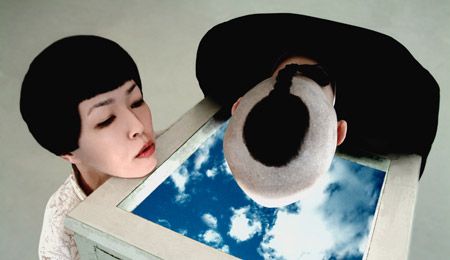
Yuko Kaseki and Shinichi Momo Iova-Koga experiment with butoh at the Japan Society
Japan Society
333 East 47th St. between First and Second Aves.
October 15-17, $18, 7:30
212-715-1258
http://www.japansociety.org
Emanating out of postwar Japan, butoh is a wide-ranging, still evolving dance form that is so hard to pin down that Yuko Kaseki, the Berlin-based Japanese dancer, choreographer, and teacher who is staging AME TO AME (CANDY AND RAIN) at the Japan Society with Shinichi Momo Iova-Koga of inkBoat, had great difficulty getting a performance visa to enter the United States for the production. Yoko Shioya, the artistic director of the Japan Society’s current season, “Japan Transatlantic: Tokio-Berlin,” writes in the show’s program, “At one point, the U.S. immigration office requested us to submit materials to prove two things: 1) that butoh is a culturally unique art form of Japan; and 2) that Yuko is a master of this art form…. The process awakened me to the fact that butoh is indeed a soil that encourages hybridity and cross-pollination in its artists.” We are all fortunate indeed that Yuko was granted that visa and that the “hybridity and cross-pollination” have been allowed to go on.
On a sparse set that contains a wooden stool, chair, and small table, Kaseki and Iova-Koga, dressed all in white but their faces not in the chalky makeup that is usually part of butoh, first walk around the stage very slowly and methodically. As they begin interacting, they are soon running around wildly to Sheila Antonia Bosco’s soundscapes and Marc Ates’s careful lighting (Ates, the cofounder of cokaseki with Kaseki, also serves as the show’s director and choreographed it with the two dancers), frolicking about in yet another display that strays from the expected butoh norms. But their sheer glee at breaking away is evident in Kaseki’s wide-eyed smile as they revel in their freedom, fight over seats, and somehow both fit on top of the table. But they pay the price for their enthusiasm when they once again slow things down to barely a crawl and the music stops completely, a silence that echoes through the theater as they display their bodies, including allowing the audience to study their every breath and the beating of their hearts resonating on their bare chests. Evoking both childlike wonder and romantic passion, AME TO AME offers a different kind of look at butoh. (For more butoh, the fourth biennial Cave New York Butoh Festival gets under way October 23; keep watching twi-ny for details.)